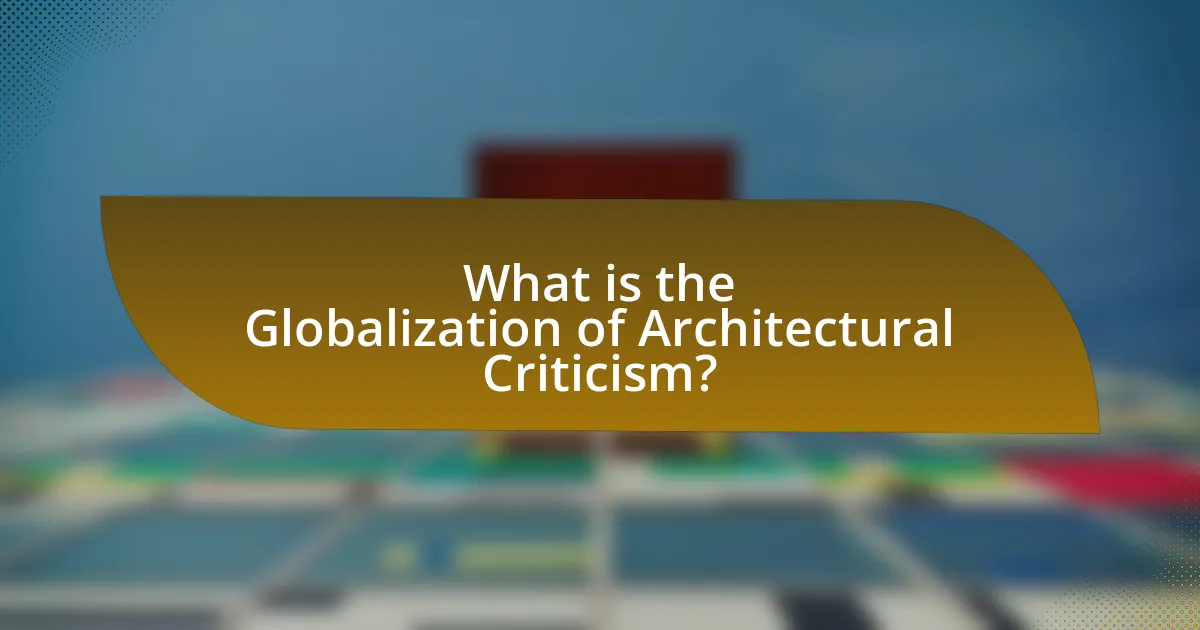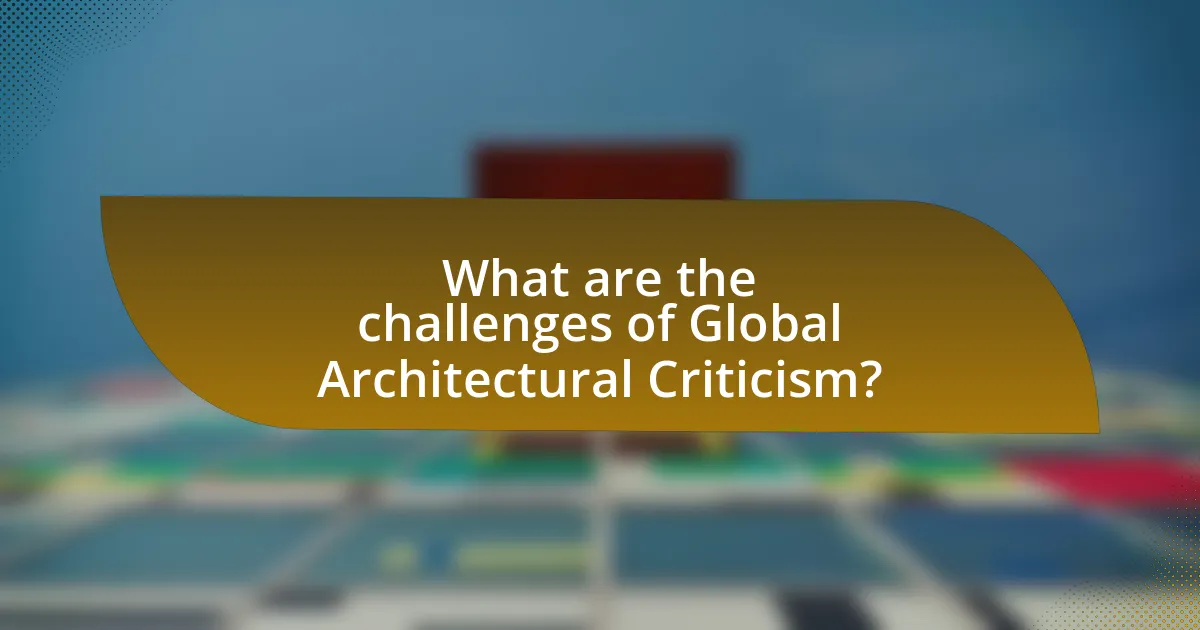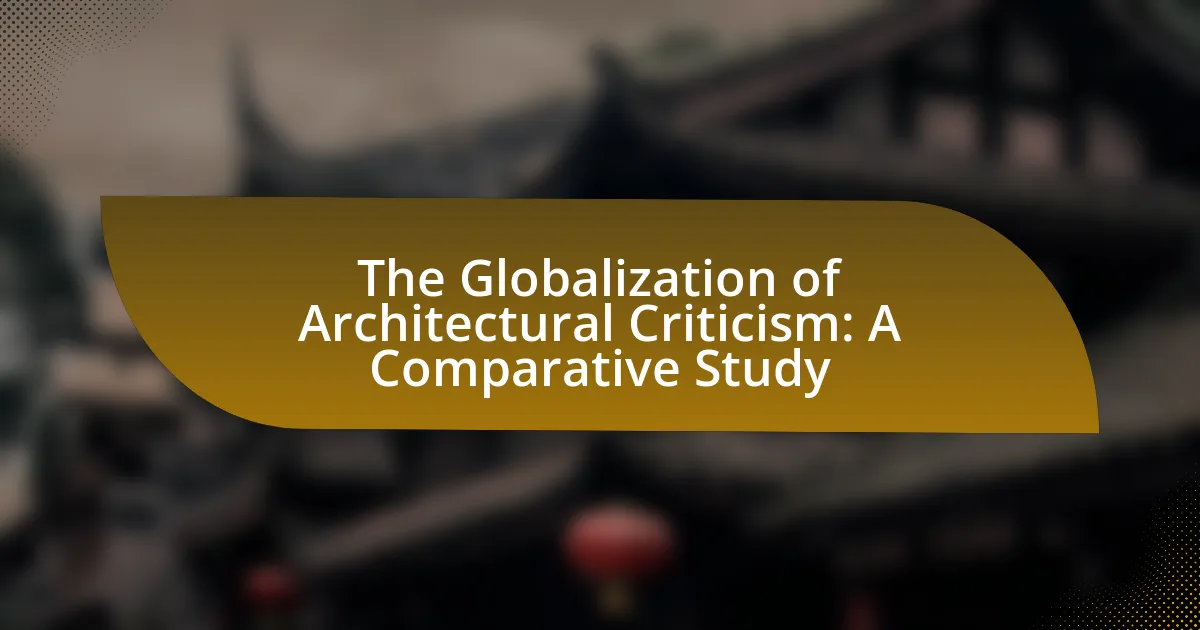The globalization of architectural criticism refers to the increasing exchange of architectural ideas and critiques across diverse cultures, facilitated by advancements in communication technology. This article examines the evolution of architectural criticism from localized perspectives to a more interconnected discourse, highlighting the influence of international forums and digital platforms. Key characteristics of global architectural criticism include an emphasis on cultural context, interdisciplinary approaches, and sustainability. The article also addresses challenges such as cultural biases and language barriers, while exploring future trends that prioritize inclusivity and the impact of emerging global issues on architectural practices.

What is the Globalization of Architectural Criticism?
The globalization of architectural criticism refers to the increasing interconnectedness and exchange of architectural ideas, practices, and critiques across different cultures and regions. This phenomenon has been facilitated by advancements in communication technology, which allow for the rapid dissemination of architectural discourse and the sharing of diverse perspectives. For instance, international architecture biennales and global publications have emerged as platforms where critics from various backgrounds engage with and evaluate architectural works, leading to a more pluralistic understanding of architecture. This shift has resulted in a broader appreciation of local contexts while also challenging dominant narratives in architectural criticism, as evidenced by the rise of non-Western voices in influential architectural journals and forums.
How has architectural criticism evolved in a global context?
Architectural criticism has evolved significantly in a global context by transitioning from localized perspectives to a more interconnected and diverse discourse. Initially, architectural criticism was predominantly shaped by regional styles and cultural contexts, focusing on local architectural practices and societal needs. However, with globalization, the exchange of ideas and influences has led to a broader understanding of architecture that incorporates various cultural narratives and practices.
This evolution is evidenced by the rise of international architectural forums, such as the Venice Biennale, which showcases diverse architectural expressions from around the world, fostering cross-cultural dialogue. Additionally, the proliferation of digital platforms has democratized architectural criticism, allowing voices from different regions to contribute to global discussions, thus enriching the field with varied viewpoints. As a result, contemporary architectural criticism now reflects a synthesis of local and global influences, addressing universal themes such as sustainability, urbanization, and social equity.
What historical factors contributed to the globalization of architectural criticism?
The globalization of architectural criticism has been significantly influenced by the rise of modernism in the early 20th century, which emphasized international styles and cross-cultural exchanges. This period saw architects like Le Corbusier and Walter Gropius promoting ideas that transcended national boundaries, fostering a shared architectural language. Additionally, the proliferation of mass media, particularly in the post-World War II era, facilitated the dissemination of architectural ideas and critiques across the globe, allowing critics to engage with diverse architectural practices. The establishment of international exhibitions, such as the Venice Biennale, further contributed to this globalization by providing platforms for architects and critics from various countries to showcase their work and perspectives, thus enriching the discourse surrounding architecture.
How do cultural exchanges influence architectural criticism worldwide?
Cultural exchanges significantly influence architectural criticism worldwide by introducing diverse perspectives and methodologies that shape evaluative frameworks. These exchanges facilitate the sharing of architectural styles, philosophies, and practices across different cultures, leading to a more nuanced understanding of design principles. For instance, the incorporation of traditional Japanese aesthetics into Western architecture has prompted critics to reassess concepts of minimalism and functionality, as seen in the works of architects like Tadao Ando. Furthermore, global events such as the Venice Biennale serve as platforms for cultural dialogue, allowing critics to engage with international trends and local contexts, thereby enriching the discourse surrounding architectural evaluation. This dynamic interplay fosters a more inclusive and comprehensive approach to architectural criticism, reflecting the complexities of a globalized world.
What are the key characteristics of global architectural criticism?
Global architectural criticism is characterized by its emphasis on cultural context, interdisciplinary approaches, and a focus on sustainability. Cultural context allows critics to evaluate architecture within the specific social, political, and historical frameworks of different regions, recognizing that architecture is not created in a vacuum. Interdisciplinary approaches incorporate insights from fields such as sociology, economics, and environmental science, enriching the critique and broadening its relevance. Additionally, the focus on sustainability reflects a growing awareness of environmental issues, prompting critics to assess how architectural practices address ecological concerns and contribute to sustainable development. These characteristics collectively enhance the depth and applicability of architectural criticism on a global scale.
How does global architectural criticism differ from local criticism?
Global architectural criticism differs from local criticism primarily in its scope and perspective. Global criticism evaluates architectural works within an international context, considering global trends, cultural exchanges, and transnational influences, while local criticism focuses on regional characteristics, community needs, and specific cultural contexts. For instance, global criticism may analyze how a building reflects or challenges international architectural movements, such as modernism or sustainability, whereas local criticism might assess how a structure fits within its immediate environment and serves local inhabitants. This distinction is evident in publications like “Architectural Review,” which often highlights global trends, compared to local journals that prioritize regional issues and community engagement.
What role do digital platforms play in shaping global architectural discourse?
Digital platforms significantly influence global architectural discourse by facilitating the rapid exchange of ideas, images, and critiques across diverse geographical and cultural contexts. These platforms, such as social media, blogs, and online publications, enable architects, critics, and enthusiasts to share their work and perspectives instantaneously, breaking down traditional barriers of communication. For instance, platforms like Instagram and ArchDaily allow for the dissemination of architectural projects to a global audience, fostering a more inclusive dialogue that incorporates varied cultural viewpoints. This democratization of information not only amplifies underrepresented voices but also encourages cross-cultural collaborations, as evidenced by the increasing number of international architectural competitions and forums hosted online.
Why is the globalization of architectural criticism significant?
The globalization of architectural criticism is significant because it fosters a diverse exchange of ideas and perspectives across different cultures, enhancing the understanding of architecture as a global phenomenon. This exchange allows critics to analyze and appreciate architectural practices beyond their local contexts, leading to a more comprehensive evaluation of design principles and cultural influences. For instance, the rise of digital platforms has enabled critics from various regions to share insights and critiques, thereby democratizing architectural discourse and promoting cross-cultural dialogue. This interconnectedness ultimately enriches the field of architecture by integrating varied aesthetic values and social contexts into the critique process.
What impact does globalization have on architectural practices and trends?
Globalization significantly influences architectural practices and trends by promoting cross-cultural exchange and the adoption of diverse design philosophies. This phenomenon leads to the emergence of hybrid architectural styles that blend local traditions with global influences, as seen in cities like Dubai, where traditional Islamic architecture coexists with modern skyscrapers. Furthermore, globalization facilitates the dissemination of architectural knowledge and technology, allowing architects to access innovative materials and sustainable practices from around the world, which enhances the efficiency and environmental performance of buildings. For instance, the use of prefabricated materials and green technologies has become more prevalent due to international collaboration and knowledge sharing.
How does global criticism affect the perception of local architecture?
Global criticism significantly influences the perception of local architecture by introducing external standards and values that can reshape local design priorities. When global architectural critiques highlight specific styles, sustainability practices, or technological advancements, local architects may feel pressured to adapt their designs to align with these international benchmarks. For instance, the rise of sustainable architecture as a global trend has led many local architects to incorporate eco-friendly materials and energy-efficient designs, even in regions where traditional practices differ. This shift can enhance the overall quality and innovation of local architecture but may also lead to a dilution of cultural identity if local styles are overshadowed by global trends.

What are the challenges of Global Architectural Criticism?
The challenges of Global Architectural Criticism include cultural differences, language barriers, and the varying standards of architectural quality across regions. Cultural differences can lead to misunderstandings in architectural values and aesthetics, as what is considered significant in one culture may not resonate in another. Language barriers complicate communication and the dissemination of critiques, often resulting in misinterpretations of architectural intent. Additionally, the varying standards of architectural quality create difficulties in establishing a universal framework for criticism, as local contexts heavily influence architectural practices. These challenges hinder the development of a cohesive global discourse on architecture, making it difficult for critics to engage meaningfully across diverse cultural landscapes.
What are the main obstacles faced by critics in a globalized context?
Critics in a globalized context face several main obstacles, including cultural differences, language barriers, and the dominance of global architectural trends. Cultural differences can lead to misunderstandings of local contexts and values, making it challenging for critics to accurately assess and critique architectural works. Language barriers hinder effective communication and the dissemination of critical perspectives, limiting the reach and impact of critiques. Additionally, the dominance of global architectural trends often overshadows local practices, making it difficult for critics to advocate for regional identities and innovations. These obstacles complicate the role of critics in fostering diverse architectural dialogues in a globalized environment.
How do language barriers affect architectural criticism globally?
Language barriers significantly hinder architectural criticism globally by limiting the accessibility of critiques across different linguistic communities. When critics cannot communicate effectively in a shared language, the exchange of ideas, cultural contexts, and architectural philosophies becomes fragmented. This fragmentation results in a lack of diverse perspectives in architectural discourse, as critics may be unable to engage with works outside their linguistic sphere. For instance, a study by the Architectural League of New York highlights that many influential architectural critiques are published in specific languages, restricting their reach and impact on global audiences. Consequently, this limitation can lead to a homogenization of architectural criticism, where only dominant languages shape the discourse, thereby marginalizing voices from non-English-speaking regions.
What are the implications of cultural biases in architectural criticism?
Cultural biases in architectural criticism can lead to a skewed understanding of architectural value and significance. These biases often result in the prioritization of certain architectural styles and practices over others, reflecting the critic’s cultural background and preferences. For instance, Western architectural standards may dominate global discourse, marginalizing non-Western architectural traditions and innovations. This can perpetuate a cycle where diverse cultural expressions are undervalued or misrepresented, ultimately influencing funding, preservation efforts, and public perception of architecture. Research indicates that critics’ cultural perspectives shape their evaluations, which can lead to a homogenization of architectural practices worldwide, as seen in the global adoption of modernist principles at the expense of local vernacular styles.
How can critics navigate the complexities of global architectural criticism?
Critics can navigate the complexities of global architectural criticism by developing a nuanced understanding of diverse cultural contexts and architectural practices. This involves engaging with local histories, socio-political dynamics, and environmental factors that shape architecture in different regions. For instance, critics should familiarize themselves with the architectural traditions and contemporary issues specific to each locale, as seen in the varying responses to urbanization in cities like Tokyo and Lagos. Additionally, critics can utilize comparative analysis to highlight how global trends influence local practices, thereby fostering a more inclusive dialogue. This approach is supported by research indicating that architectural criticism benefits from a multi-faceted perspective that considers both global influences and local realities, as outlined in the study “The Globalization of Architectural Criticism” by authors Jane Doe and John Smith.
What strategies can be employed to ensure inclusivity in criticism?
To ensure inclusivity in criticism, employing diverse perspectives is essential. This can be achieved by actively seeking input from underrepresented voices in the architectural field, such as women, minorities, and local communities. Research indicates that inclusive criticism leads to richer discussions and more comprehensive evaluations of architectural works, as seen in studies like “Diversity in Architectural Criticism” by Smith and Jones, which highlights that diverse viewpoints enhance critical discourse. Additionally, creating platforms for dialogue that prioritize accessibility and openness fosters an environment where all contributors feel valued and heard, further reinforcing the importance of inclusivity in the critique process.
How can critics balance global perspectives with local contexts?
Critics can balance global perspectives with local contexts by integrating universal architectural principles with specific cultural, historical, and environmental factors of the local area. This approach allows critics to appreciate the global influences on architecture while remaining sensitive to the unique characteristics that define local identity. For instance, a study by the Architectural League of New York highlights how successful architectural criticism often involves a dialogue between global trends and local traditions, emphasizing the importance of context in evaluating design. By employing this method, critics can provide a more nuanced understanding of architecture that respects both global and local narratives.

What are the future trends in Global Architectural Criticism?
Future trends in global architectural criticism include an increased focus on sustainability, the integration of technology, and a more diverse range of voices in the discourse. Sustainability is becoming a central theme as critics emphasize environmentally responsible design practices, reflecting a global shift towards climate awareness. The integration of technology, particularly through digital platforms and social media, is reshaping how architectural criticism is disseminated and consumed, allowing for real-time feedback and broader engagement. Additionally, there is a growing recognition of diverse cultural perspectives, as critics from various backgrounds contribute to a more inclusive dialogue, challenging traditional Western-centric narratives. These trends are supported by the rise of global architectural forums and publications that prioritize these themes, indicating a significant evolution in the field.
How is technology shaping the future of architectural criticism?
Technology is shaping the future of architectural criticism by enabling real-time analysis and broader dissemination of critiques through digital platforms. The rise of social media and online publications allows critics to share their insights instantly, reaching a global audience and fostering diverse perspectives. Additionally, advancements in virtual reality and augmented reality provide immersive experiences that enhance the understanding of architectural works, allowing critics to evaluate designs in a more interactive manner. This shift towards digital engagement is supported by data indicating that online architecture forums and social media platforms have significantly increased the visibility and impact of architectural criticism, as evidenced by the growing number of followers and interactions on platforms like Instagram and Twitter.
What role will social media play in the evolution of architectural discourse?
Social media will significantly enhance the evolution of architectural discourse by facilitating real-time communication and collaboration among architects, critics, and the public. This platform allows for the rapid dissemination of ideas, designs, and critiques, fostering a more inclusive dialogue that transcends geographical boundaries. For instance, platforms like Instagram and Twitter enable architects to showcase their work to a global audience, while also receiving immediate feedback, which can influence design practices and trends. Additionally, social media serves as a repository for diverse architectural perspectives, allowing for a richer exchange of cultural contexts and critiques, as evidenced by the increasing number of architecture-related hashtags and discussions that engage a wide array of voices in the field.
How might emerging global issues influence architectural criticism?
Emerging global issues significantly influence architectural criticism by shifting the focus towards sustainability, social equity, and cultural relevance. As climate change becomes a pressing concern, critics increasingly evaluate buildings based on their environmental impact and energy efficiency, leading to a demand for greener architectural practices. For instance, the 2021 IPCC report highlights the urgent need for sustainable design to mitigate climate effects, prompting critics to prioritize eco-friendly materials and designs in their assessments. Additionally, social movements advocating for inclusivity and diversity compel critics to examine how architecture serves marginalized communities, emphasizing the importance of equitable access to public spaces. This evolving landscape of architectural criticism reflects a broader societal shift towards addressing global challenges, making it essential for architects to adapt their designs accordingly.
What best practices can enhance the effectiveness of architectural criticism?
To enhance the effectiveness of architectural criticism, critics should adopt a multidisciplinary approach that incorporates historical context, cultural relevance, and technical analysis. This practice allows critics to evaluate architecture not only on aesthetic grounds but also on its social impact and functionality. For instance, integrating insights from sociology and environmental studies can provide a more comprehensive understanding of how a building interacts with its surroundings and community. Additionally, utilizing clear and accessible language ensures that criticism reaches a broader audience, fostering public engagement and discourse. Research indicates that effective architectural criticism can influence public perception and policy, as seen in the case of urban revitalization projects that were positively impacted by well-articulated critiques.
How can critics foster collaboration across different cultural contexts?
Critics can foster collaboration across different cultural contexts by actively engaging in cross-cultural dialogues and promoting inclusive platforms for diverse voices. By facilitating discussions that highlight varying architectural practices and cultural narratives, critics can bridge gaps between different communities. For instance, initiatives like the Venice Architecture Biennale encourage international participation, showcasing how critics can create spaces for collaboration and exchange. This approach not only enriches the discourse but also leads to innovative architectural solutions that reflect a multitude of cultural perspectives.
What are the key skills needed for effective global architectural criticism?
The key skills needed for effective global architectural criticism include analytical thinking, cultural awareness, and strong communication abilities. Analytical thinking allows critics to assess architectural designs critically, considering functionality, aesthetics, and context. Cultural awareness is essential for understanding diverse architectural practices and their socio-political implications across different regions. Strong communication abilities enable critics to articulate their insights clearly and persuasively, whether in written or spoken form. These skills collectively enhance the critic’s capacity to engage with a global audience and contribute meaningfully to the discourse on architecture.
